According to a recent State of User-Generated Content report, nearly 80% of consumers feel that they can tell when a brand is advertising to them. Moreover, almost 40% of consumers distrust paid influencers.
Where does that leave brands looking to genuinely connect with their customers and showcase their products? One option is user-generated content.

User-generated content isn’t a magic potion to cure all your marketing woes. However, it will improve your overall customer experience by building trust, encouraging customer loyalty, and building brand awareness.
How? In this post, we’ll talk about
- What user-generated content is
- Benefits of user-generated content for your marketing strategy
- The different types of UGC
- How to compel your customers to create this content for you
Let’s dive in.
What is user-generated content?
User-generated content (UGC) is content created by your loyal customers, prospects, and followers. It’s often created as folks use your product, service, or app, and it exists in the form of blog posts, ratings, photos, reviews, and other contributions.
At first glance, UGC may seem similar to influencer marketing. However, influencer marketing is akin to paid advertising in that they both rely on paid content creators.
UGC strategy features content created by real people and customers, either for free or for some sort of reward. UGC marketing campaigns are also a cost-effective way to source visual content and enhance customer experience.
Benefits of user-generated content
Some additional benefits of user-generated content include:
- Increased trust. Consumers trust other consumers, so by sharing content directly from your customers, you can build trust and increase social proof.
- Expanded social reach. When you share content created by your customers, you can increase your business’s social reach–especially if they reshare your post or are tagged in the post on social media.
- Free promotion. User-generated content is usually content customers are creating for free, which means you’re getting the benefit of promoting your business without spending any of your marketing budget.
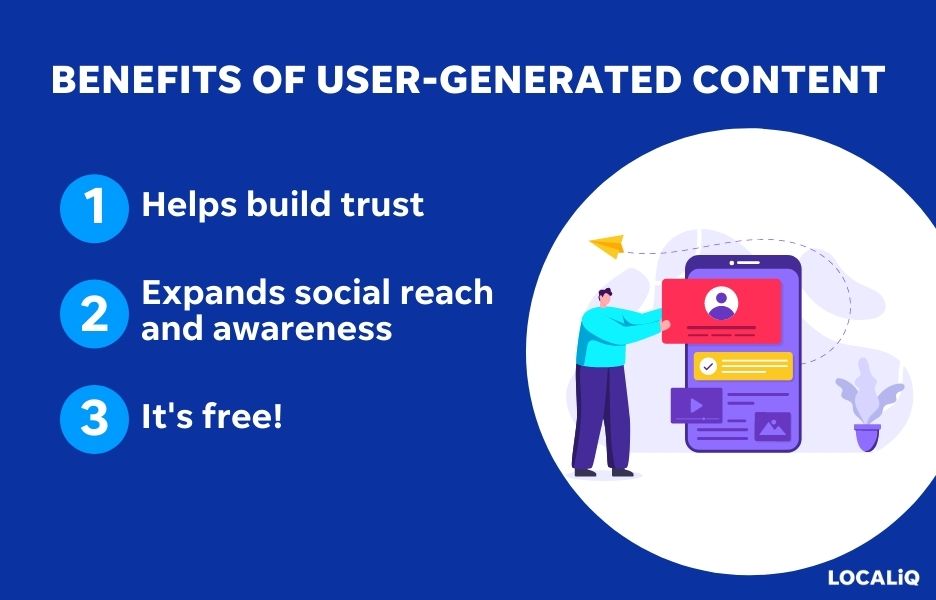
6 types of user-generated content (+why they work!)
What are the types of user-generated content you should aim to collect as part of your marketing strategy? Let’s explore.
1. Social media posts
When someone mentions UGC, social media typically springs to mind. This is likely because most posts on social media platforms that feature brands are user-generated content.
These days, posts are coming from a wide variety of sources—news sites, friends, brands, and even celebrities. This presents an opportunity for marketers to connect with their customers in new ways. Good news, given that consumers are nearly 3x more likely to engage with a brand’s social media content than any other type of media they create.
Brands can curate and repost user-generated content to their social media platforms and engage with customers online. It’s a win-win situation—just don’t forget to credit the customer.
Consider this post by Airbnb, for instance.
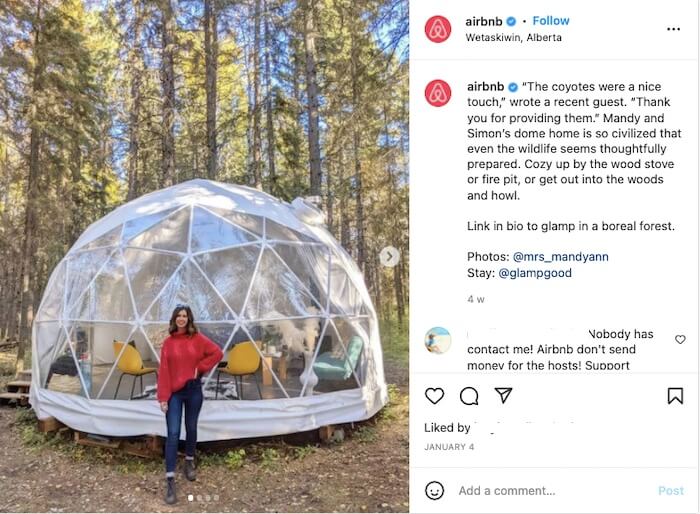
Airbnb shared genuine customer content featuring a real guest at a real Airbnb experience—not a staged photo shoot. This can go a long way with customers looking for insight into booking with Airbnb.
Related: Check out these 13 social media hacks every small business should try.
2. Customer reviews and testimonials
Customer reviews and testimonials are a powerful form of UGC for your website. They offer an effective way to showcase what other customers are saying about your product or service. This, in turn, furthers your message, collects social proof, and builds credibility with potential customers.
Businesses that overlook reviews and testimonials are missing out on expanding their reach and converting potential customers—72% of consumers find reviews submitted by customers more credible than brands talking about their own products.
A recent survey of 2,000+ consumers (across the U.S., UK, and Australia) found that the majority of young people claimed they left an e-commerce store without making a purchase. The culprit? A lack of customer reviews or photos.
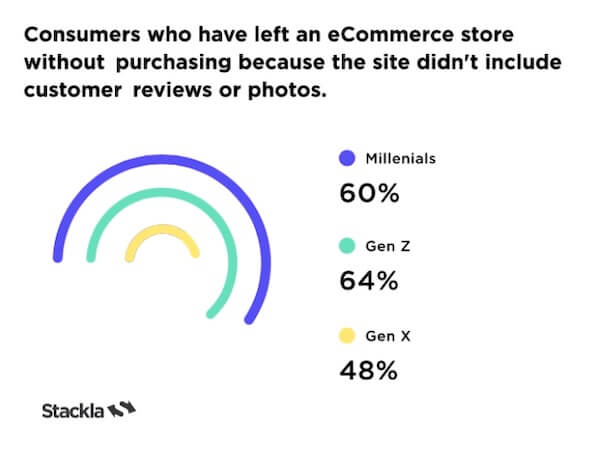
Related: Get more online reviews statistics here.
3. User videos
User-generated content doesn’t always have to be photos on Instagram or reviews on your website. UGC also comes in the form of videos on YouTube, TikTok, Instagram stories, or IGTV. These videos often describe how to use your product or give a visual overview of your product or services.
Consider this YouTube review.
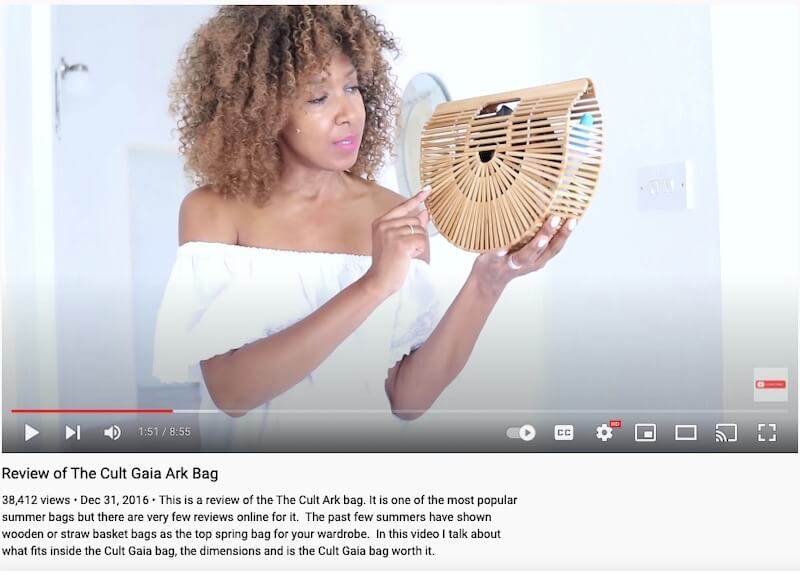
This UGC video showcases and describes the customer’s fondness for the Cult Gaia Ark Bag. The video brings more followers into the conversation through comments and social sharing, which in turn enhances brand awareness and affinity. Better yet, the cost to the company was nothing
Ask your customers to capture video showcasing their experiences with your product or brand. These engender brand loyalty, reach a wider audience, and increase sales—often better than a professionally-shot marketing video could.
4. Blog posts
A recent surge in independent bloggers and journalists over the last decade creates a unique opportunity for your brand.
Soliciting bloggers and other writers to create content about your brand and product(s) brings fresh perspectives and expands your reach to new audiences and eyeballs. Product reviews, how-to tutorials, and comparison posts mean more visitors that are aware of your brand.
While content marketing is highly valuable for small businesses, relying only on your blog limits your reach and can often come across as sales-y.
5. Case studies
Case studies are published pieces that showcase how your service or product was used in an organization and what value it brought. They offer real-life stories of problems your products or services solved.
Ask users to describe their experience and embed their video in case studies on your site. This showcases your work to new visitors, and your customer gets exposure for their brand.
Just like this example case study.

The word-of-mouth cycle doesn’t have to end here. Share your case study content via social media and ask the customer you featured to share it, too. Each time you do, you increase your reach significantly.
6. Live events
Whether held in-person or online, live events are a unique opportunity to capture user-generated content.
Live events are designed to create camaraderie and celebration around your product or brand. Unique activities, unique speakers, and fun photo opportunities encourage guests to take and share photos, thus promoting your event through their networks.
You can also boost engagement with online events by allowing users to post comments and questions as well as take polls.
How to generate user-generated content
For UGC to be effective with your audience—for it to build trust and drive sales—it needs to be a proactive, intentional part of your marketing plan.
So, how do you collect these posts regularly and naturally? Here are some clever ways to collect user-generated content and stand out from your competition.
1. Hashtag your way to viral content
Hashtag campaigns are a simple way to engage your audience and collect UGC.
Campaigns usually run for a limited period. By posting UGC with a unique hashtag, customers can easily share content featuring your brand or product that you can repost on your website or social media profiles.
Here are a few tips for collecting UGC via hashtags:
- Create a unique, memorable hashtag
- Add the hashtag to your bio for easy access
- Promote it on channels that use hashtags, including Instagram and Twitter
- Communicate the incentives (if any) explicitly
- Measure your results to see if you’re meeting your goal
As an example of effective hashtag usage, take a look at the famed #MYCALVINS hashtag campaign.
Calvin Klein invited users to share photos of themselves wearing a pair of their favorite Calvin Klein underwear using the hashtag #MYCALVINS for a chance to be featured on their Instagram page.
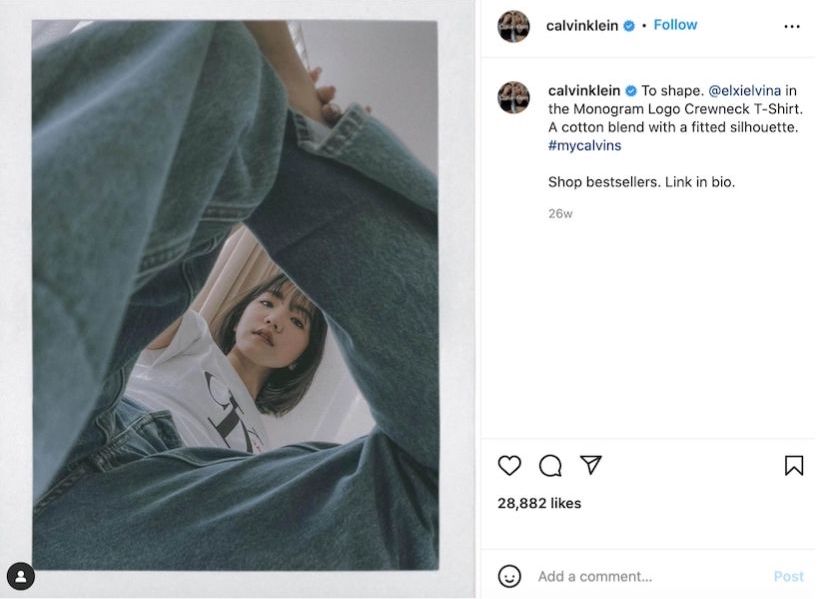
Calvin Klein teases the chance to be featured on its website, too.
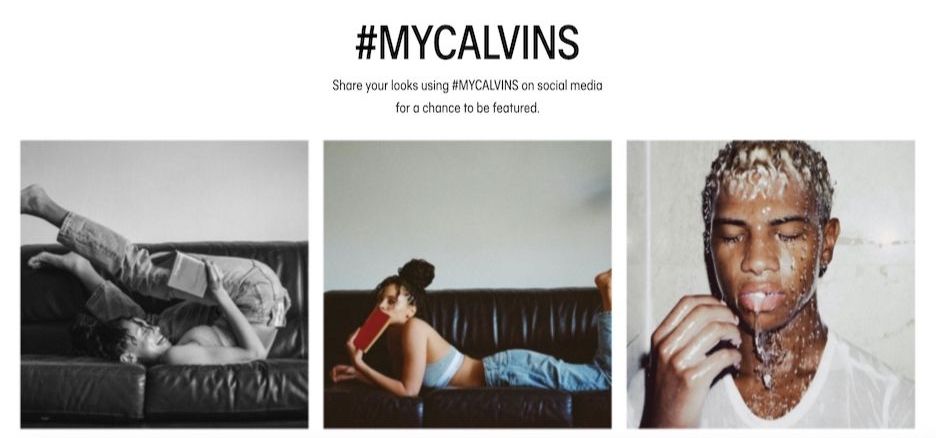
The campaign was an immediate hit, and since its debut in 2014, the campaign has continued to grow organically. Today it has 908,886 posts on Instagram—creating a perpetual stream of UGC for Calvin Klein.
However, the lure of getting a repost from your brand might not be sufficient for every customer, especially if your brand is not yet a household name.
In this case, offer people another incentive. Announce prizes for customers who come up with the most creative posts or gather the most shares or likes on their content. Depending on your budget and target audience, prizes can be anything from a free product to a trip to Hawaii.
This is also a great opportunity for running a Facebook contest or Instagram giveaway so you can collect more user-generated content while rewarding your followers.
2. Use email requests for reviews and testimonials
Many companies lose out on sales purely because of a lack of reviews. 50 or more reviews per product may result in a 4.6% increase in conversion rates.
Imagine viewing a product on Amazon with zero reviews. Despite high-quality photos or witty ad copy, you’d probably still feel wary of spending your money. Without UGC, there’s nothing to trust.
Emailing your customers is a successful way to gather reviews for your products. Ask people for their honest feedback and testimonials, and they are more likely to share their opinion.
Consider this email by G2, for instance:
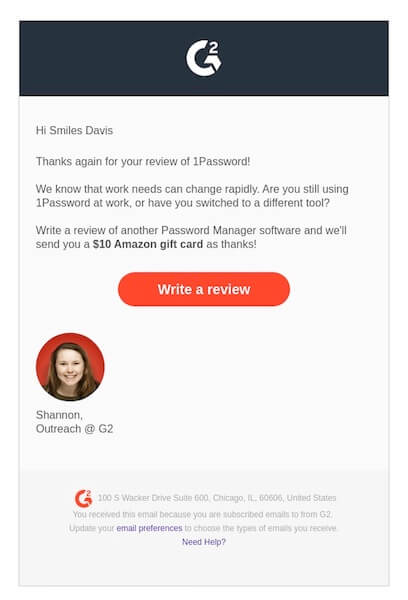
In most cases, that’s all you have to send. By simply reaching out and offering an incentive, customers are more likely to add to your UGC efforts.
Here are a few tips for collecting UGC via emails:
- Ensure recipients recognize your email with branded elements and language
- Incentivize reviews (e.g., coupons codes, discount offers, or free products)
- Make it easy for customers to share their reviews, whether on your site or third-party review sites
- Consider adding a link within the email itself for customers to leave a review, or allow them to simply respond with their review in the body of an email. The less work, the better
Get our email templates to make asking for reviews easy!
3. Encourage customers to create unboxing videos
Customers love to see behind-the-scenes footage, and that includes unboxing videos. Instead of waiting for customers to create their own, consider doing so with your own team.
Film fun, personality-driven videos with your employees unboxing new products, perhaps those that aren’t yet released.
Then invite your customers to create similar videos—again, offering rewards and incentives for the most creative or most shared videos.
Consider Loot Crate as a case study:
Loot Crate, an e-commerce service for gaming-related merchandise, created a tight-knit community of people on the bleeding edge of geek culture.
The initial customer intrigue was simply getting a box of surprising “geeky goodness” delivered to their homes. However, the fact that they didn’t know what was in the box was an opportunity to engage with them.
Loot Crate created unboxing videos to give their customers an extra level of intrigue and excitement. Loot Crate also provides coupon codes to customers who pass a certain threshold of views.
The result? YouTube is now inundated with organically created Loot Crate unboxing videos.
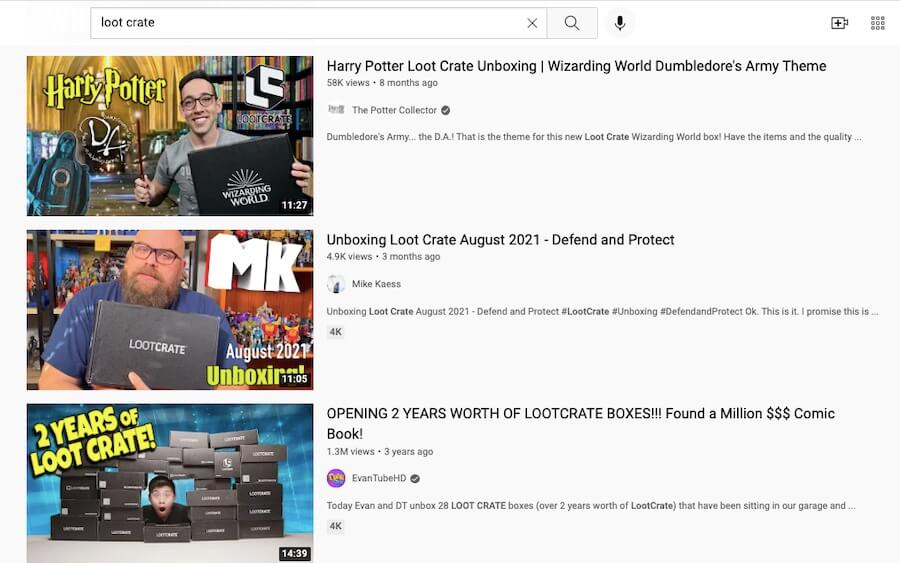
The key to gathering user-generated unboxing video content is attractive packaging. Your customers are more likely to create unboxing videos that feature beautiful, personalized packaging versus a boring cardboard box.
Look at this jaw-dropping package design.

Packaging like this entices your customers to create and share unboxing videos (or photos!) just to gush over the presentation itself. You can also offer giveaways to encourage more people to participate.
4. Write a blog post featuring industry experts
People love learning from industry leaders.
Your blog is an opportune platform to share opinions, experiences, and insights from professionals and experts. Experts add credibility to your blog and introduce their audience(s) to your publication. By curating the leading voices in your industry, you become a trusted source of information and inspiration.
Let’s see this in action.
MarketerHire, a talent-hiring platform, surveyed industry experts and wrote a blog post featuring their thoughts.
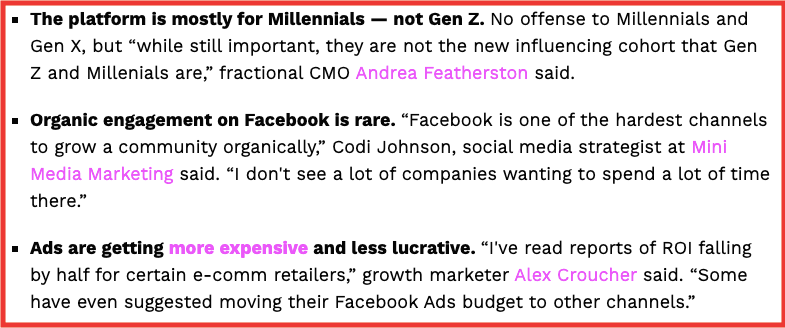
After publishing the blog post, MarketerHire then emailed these expert contributors with promotional graphics, a photo, and a short quote to encourage them to share the post on social media. This not only helped the expert produce content, but it showcased MarketerHire to a brand new audience.
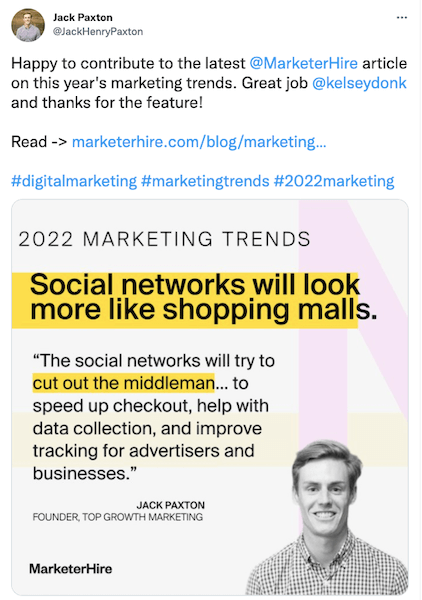
This method helps your team easily create content while simultaneously receiving user-generated content. Two birds, one stone.
Get started with user-generated content
If storytelling is the heart of a brand, then user-generated content is the soul—it’s raw feedback from real people.
The truth is that customers can sell your product or service far better than you can. You just have to make it easy for them to do so—through methods like hashtag campaigns, email reminders, unique incentives, and educational content.
To stand out in today’s sea of marketing drivel, use UGC as a way to promote your brand, build long-term relationships with customers, and help your business succeed.
Related Articles
-

Content Marketing vs. Social Media Marketing: The Strategy Showdown
-

The Small Business Guide to AI Content Marketing: Tips, Tools & Precautions
-

What Is Direct Response Copywriting? (7 Best Practices + Examples)
-

50 Powerful Call-to-Action Phrases to Convert More Customers (with Examples)
-

22 Tried & True Content Marketing Ideas for Small Businesses

